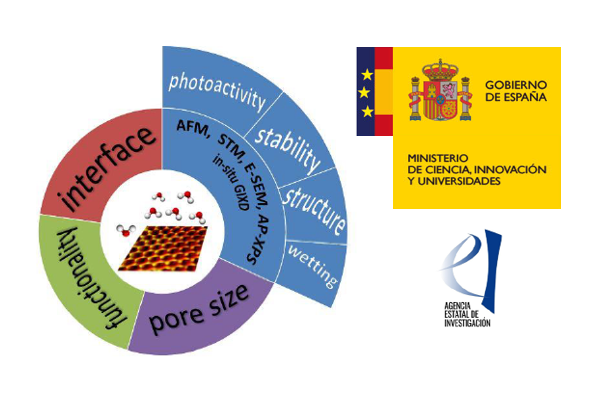
FESTA: Photochemistry and stability of organic/water model interfaces for water splitting (PID2019-110907GB-I00)
OSCs photoelectrodes are promising for photoelectrochemical water splitting, which gains more attention every year. The stability of the photoelectrodes still remains a major performance constraint. Few factors might contribute to the observed photocurrent decay, including chemical or morphological/structural transformation and photochemical degradation of the OSC materials. However, the rationale behind the factors affecting stability and water splitting mechanism has not been properly understood yet. From a molecular perspective, very little is known about the photochemical surface reaction, the interaction of absorbed water molecules with specific molecular sites and how water affects the structural and electronic properties of the OSCs films. We would like to mention a recent work that has identified the role of water in charge trapping in OSCs polymers. It has been proposed that the origin of the traps is due to a dielectric effect of water penetrating nanovoids in the organic semiconductor thin film. This proposal aims at advancing our understanding on the crucial role of structural and chemical factors at model interfaces of interest for water splitting, at the intersection of precisely controlled surfaces/interfaces and advanced in-situ characterization tools.
Solution processed organic semiconductors (OSCs) are a promising class of materials to enable low-cost and high performance fuel production. The advantages of solution-processable OSCs and their success in organic photovoltaic devices have triggered the interest of optimizing their properties for operation in photocatalytic water splitting devices. Within this scenario, an approach is the use OSCs as photoelectrodes for visible-light water splitting. Although the stability of the materials in aqueous environment remains a major performance limitation, the rationale behind the factors affecting the stability and water splitting mechanisms has not been properly understood yet. The goal of this proposal is to provide a nanoscopic picture of the OSC/water interface and an understanding of the photochemical processes by in-situ characterization methods. The bottom-up growth of conjugated 2D-COFs with a tailored variation of the pore size and hydrophilic/hydrophobic character will allow us to advance the understanding of the crucial role of structural and chemical factors at organic/water model interfaces of interest for water splitting. Our research group combines large expertise in the fields of OSCs growth and water on surfaces as well as in a wide spectrum of advanced surface characterization techniques and in-situ characterization methods. We expect that the results will provide ground ideas for the design of materials with improved performance and stability for photocatalytic water splitting applications.
